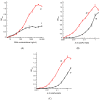Rapid Detection of Lipopolysaccharide and Whole Cells of Francisella tularensis Based on Agglutination of Antibody-Coated Gold Nanoparticles and Colorimetric Registration
- PMID: 36557493
- PMCID: PMC9784915
- DOI: 10.3390/mi13122194
Rapid Detection of Lipopolysaccharide and Whole Cells of Francisella tularensis Based on Agglutination of Antibody-Coated Gold Nanoparticles and Colorimetric Registration
Abstract
The paper presents development and characterization of a new bioanalytical test system for rapid detection of lipopolysaccharide (LPS) and whole cells of Francisella tularensis, a causative agent of tularemia, in water samples. Gold nanoparticles (AuNPs) coated by the obtained anti-LPS monoclonal antibodies were used for the assay. Their contact with antigen in tested samples leads to aggregation with a shift of absorption spectra from red to blue. Photometric measurements at 530 nm indicated the analyte presence. Three preparations of AuNPs with different diameters were compared, and the AuNPs having average diameter of 34 nm were found to be optimal. The assay is implemented in 20 min and is characterized by detection limits equal to 40 ng/mL for LPS and 3 × 104 CFU/mL for whole cells of F. tularensis. Thus, the proposed simple one-step assay integrates sensitivity comparable with other immunoassay of microorganisms and rapidity. Selectivity of the assay for different strains of F. tularensis was tested and the possibility to choose its variants with the use of different antibodies to distinguish virulent and non-virulent strains or to detect both kinds of F. tularensis was found. The test system has been successfully implemented to reveal the analyte in natural and tap water samples without the loss of sensitivity.
Keywords: agglutination; colloidal gold; express diagnostics; immunoanalysis; lipopolysaccharide; tularemia.
Conflict of interest statement
The authors declare no conflict of interest.
Figures










Similar articles
-
Development of Immunoassays for Detection of Francisella tularensis Lipopolysaccharide in Tularemia Patient Samples.Pathogens. 2021 Jul 22;10(8):924. doi: 10.3390/pathogens10080924. Pathogens. 2021. PMID: 34451388 Free PMC article.
-
Automated microfluidically controlled electrochemical biosensor for the rapid and highly sensitive detection of Francisella tularensis.Biosens Bioelectron. 2014 Sep 15;59:342-9. doi: 10.1016/j.bios.2014.03.024. Epub 2014 Apr 12. Biosens Bioelectron. 2014. PMID: 24747573
-
Electrochemiluminescence (ECL) immunosensor for detection of Francisella tularensis on screen-printed gold electrode array.Anal Bioanal Chem. 2016 Oct;408(25):7147-53. doi: 10.1007/s00216-016-9658-x. Epub 2016 Jun 2. Anal Bioanal Chem. 2016. PMID: 27255102
-
Comparative review of Francisella tularensis and Francisella novicida.Front Cell Infect Microbiol. 2014 Mar 13;4:35. doi: 10.3389/fcimb.2014.00035. eCollection 2014. Front Cell Infect Microbiol. 2014. PMID: 24660164 Free PMC article. Review.
-
[Francisella tularensis--feature of pathogen, pathogenesis, diagnostics].Przegl Epidemiol. 2006;60(3):601-8. Przegl Epidemiol. 2006. PMID: 17249186 Review. Polish.
Cited by
-
Gold Nanoparticle-Based Colorimetric Biosensing for Foodborne Pathogen Detection.Foods. 2023 Dec 27;13(1):95. doi: 10.3390/foods13010095. Foods. 2023. PMID: 38201122 Free PMC article. Review.
References
Grants and funding
LinkOut - more resources
Full Text Sources
Miscellaneous

